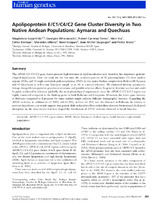Apolipoprotein E/C1/C4/C2 gene cluster diversity in two native andean populations : Aymaras and Quechuas

View/
Date
2012-07Author
Gayá-Vidal, Magdalena
Athanasiadis, Georgios
Carreras-Torres, Robert
Via, Marc
Esteban, Esther
Villena, Mercedes
Vásquez, René
Dugoujon, Jean-Michel
Moral, Pedro
Metadata
Show full item recordAbstract
Summary.
The APOE/C1/C4/C2 gene cluster presents high relevance in lipid metabolism and, therefore, has important epidemiological implications. Here, we study for the first time the variation patterns of 25 polymorphisms (10 short tandem repeats, STRs, and 15 single nucleotide polymorphismas, SNPs) in two native Andean samples from Bolivia (45 Aymaras
and 45 Quechuas) as well as one European sample (n = 41) as external reference. We estimated diversity parameters,
linkage disequilibrium patterns, population structure, and possible selective effects. In general, diversity was low and could
be partly attributed to selection (probably due to its physiological importance), since the APOE/C1/C4/C2 region was
highly conserved compared to the flanking genes in both Bolivians and Europeans. Moreover, the lower gene diversity
in Bolivians compared to Europeans for some markers might indicate different demographic histories. Regarding the
APOE isoforms, in addition to ε3 (94%) and ε4 (5%), isoform ε2 (1%) was also detected in Bolivians. In relation to
previous hypotheses, our results support that genetic drift or founder effects rather than selection for increased cholesterol absorption are the main factors that have shaped the distribution of APOE isoforms observed in South America.
